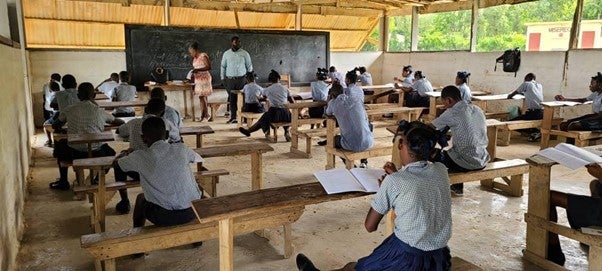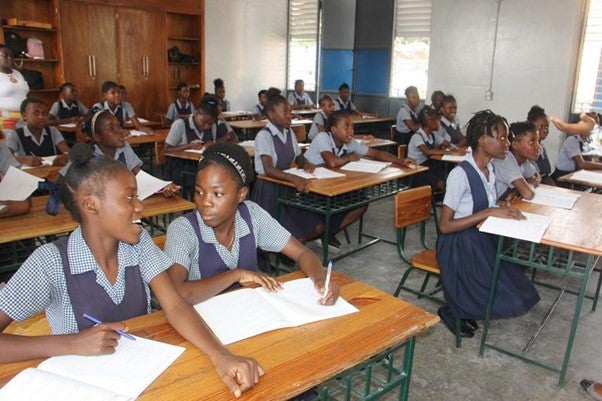Following the publication of the presidential decree in September 2014 relating to the reform of the schools functioning in Haiti, national achievement tests (or national exams) in the 6th and 12th grades (6e AF and Rhéto) were eliminated officially. As clause 3 of the decree stipulated, the Ministry of National Education and Professional Development (MENFP) should organize targeted national evaluation sessions from the 4th grade on basic disciplines. This decree is often called the “12 measures decree,“ which aimed to redress, improve, and reform the Haitian education system.
Hence, in 2015, the MENFP with the technical and financial support of the Inter-American Development Bank (IDB), the Haitian Institute of Training in Educational Sciences (IHFOSED), and support from the International Evaluation Association of School Achievement (IEA) embarked on a joint effort to improve the quality of the education system, with the introduction of national evaluations in French, Creole, and mathematics in the 4th grade of primary education as stipulated under clause 3 of the 12 measures.
Evolution of the Haitian National Assessments over the years
Pre-pilot in 2015
In 2015, the Ministry introduced a national evaluation in the 4th grade to replace the existing 6th-grade exams. The 4th grade National Assessment was meant to generate meaningful information about students’ level of proficiency before the end of primary education to allow the MENFP to apply corrective measures where necessary before students transition to secondary education. Informed on MENFP census data, IEA developed a sample of 60 schools throughout Haiti for the pre-pilot.
Therefore, the pre-pilot phase sample was not treated as a random selection of schools but rather as a convenience sample. The MENFP, with IHFOSED’s support, organized the collection and entry of data from the pre-pilot assessment.
A significant finding from the pre-pilot was that even the most accessible items from the international Assessments proved too challenging for 4th graders in Haiti. While still difficult, the same assessment proved to be more appropriate when administered to 6th-grade students. While the test administration in 2015 worked well, specific challenges regarding the consistency of student tracking information and availability of material during the testing sessions were observed and required improvement in upcoming assessments.
2016 Pilot and First Representative Sample of the National Evaluations
Based on 2015 observations, a 2-week seminar was organized to develop a set of items specifically adapted to the Haitian educational context. Having first developed “specification tables” to guide the formulation of the items, the team of representatives of MENFP, IHFOSED, and other education experts in Haiti formulated 361 items to be tested in 2016. These items became the 2016 pilot evaluation, administered to a non-representative sample of 40 schools in the country and followed by the first National Evaluation, which was administered to a representative sample of 526 schools in 10 departments of the country. The pilot test was composed of three achievement portions: Mathematics, Creole, and French, and three background questionnaires, which were administered to 2,267 students (amended to the achievement portions), 55 teachers, and 38 school directors (limited to one school director per school).
2017 National Evaluations
In 2017, the MENFP decided to expand the scope of tested schools to conduct a census for the public school sector – i.e., to include all public schools that offered education to 4th-grade students in the country. IEA’s sampling team provided an additional sub-sample of 82 non-public schools to maintain a representative sample of the gathered data for the whole country’s educational system.
The sample of non-public schools was stratified by department. Ultimately, 52,142 students in 1,771 public schools and 6,770 students in 204 non-public schools were assessed. The census sample of public schools allowed the collection of highly reliable and precise descriptions of the Haitian population of fourth-grade students. IHFOSED adapted the evaluation instruments (tests, students, teachers, school director questionnaires, and tests of the administration manual), recruited and trained test administrators and supervisors, trained data entry operators, and entered data resulting from the 2017 assessment.
Finally, IHFOSED also supported disseminating results in collaboration with the MENFP. The data was then submitted to the IEA, which cleaned and processed the data.
2022 National Evaluations
In the most recent national evaluation in 2022, the IDB, in concertation with the MENFP, IEA, and IHFOSED, agreed that the evaluation would be done in the 6th rather than the 4th grade. It was also agreed that the efforts of the IFHOSED and IEA would focus on supporting the MENFP’s capacity to manage the evaluations directly to enhance the skills and knowledge of local education professionals in Haiti involved in evaluations. IHFOSED, in concertation with the MENFP, provided its expertise to support sample selection, test development workshops, pre-testing of tests in schools not part of the 6th-grade samples, training of test administrators, test administration, and training of data entry operators.
IEA was involved after the instrument development step to provide technical support for data entry and verification, sampling/weighting, and reporting.
The current cycle of the national evaluation now allows the link of tested students with their teachers and, therefore, provides the possibility to report teacher variables in association with their students’ achievement. However, due to the insecurity in Haiti around the test administration period, not all targeted schools could be assessed. After cleaning, The overall collected data recorded 37,171 students from 1,456 schools, of which 1,412 schools were public schools, corresponding to about 69% of the schools listed for the public school census. Likewise, with 35,816 non-excluded participating students, about 69% of the students listed as being enrolled in 6th grade took part in the national evaluation.

Knowledge Transfer and Capacity Strengthening
In terms of knowledge transfer, IHFOSED trained and engaged 33 employees from the MENFP Primary Education Directorate (DEF) and other technical directorates in the elaboration of tests and questionnaires, writing manual for test administration, analyzing pre-test data, training 25 departmental focal points for the training of 2,312 test administrators and 1,677 supervisors. In addition, 120 data entry operators were also trained to use IEA software, of which 20 were from MENFP.
Hence, the DEF received 20 laptops to complete the data entry task. Finally, all activities, including workshops and seminars, which were done in the scope of 2022 National Evaluations, were completed in concertation with the MENFP to ensure knowledge transfer and capacity strengthening.
You could also be interested: How Are Call Centers Helping Education in Haiti?
Key Take-Aways from National Assessments
Although a direct comparison between national evaluation data is not possible given that the test instruments were redeveloped for each cycle and administered in different school years, the results of the 2022 Haiti National Evaluation show a similar general pattern of strengths and challenges within the Haitian education system, confirming many findings already reported in previous cycles. These similarities/patterns include:
- Students across the board perform better in their mother tongue language (Creole) ;
- Girls tend to outperform boys in language subjects slightly;
- Students in bilingual households score better across all subjects;
- Performance varies significantly by department, with rural areas lagging;
- Lack of basic resources and supplies cited as an issue by schools;
- Limited access to electricity, water, internet, and computers prevails at home and in schools ;
- High rates of teacher absences likely impact instructional time and learning;
- Students have a positive attitude towards learning despite challenges
Nex steps and Moving Forward in Haiti
The MENFP is collaborating with the Information Systems Unit (USI) to transfer all existing National Evaluation reports and collected data within its Education Management Information System (EMIS).
Secondly, in a concerted effort to enhance student performance within schools in Haiti, the MENFP, with financial backing from the IDB, has initiated a diagnostic assessment of the Haitian curricula as part of its ongoing Support to the Haiti Education Sector Plan operation.
This diagnostic analysis will serve as the foundation for identifying key areas for curriculum reform in Haiti, which will be funded through the forthcoming Support to the Haiti Education Sector Plan 2.0, currently in the preparation phase. Finally, as part of this curricular reform, the Haitian MENFP evaluation and assessment system is being revised and redesigned to ensure that evaluations and assessments are being used to provide teachers with information to improve teaching in the classroom and to ensure that the MENFP central level has reliable information for decision making.
What do you think about the importance of having quality information for educational assessment? Please leave us your comments!


Leave a Reply